Andrea 54mm "Napoleon at Fontainebleu" | 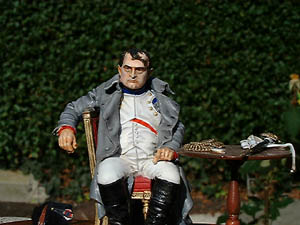 | Introduction 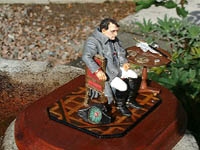 As some readers will know for most of the last 10 years I have exclusively modelled large scale Native American subjects. However, by September 2002 I decided to return to 54mm as well as simply making whatever took my fancy. As some readers will know for most of the last 10 years I have exclusively modelled large scale Native American subjects. However, by September 2002 I decided to return to 54mm as well as simply making whatever took my fancy.
The good thing about taking 10 years out is, it is just like taking up the hobby for the first time - there are hundreds of brilliant figures waiting for me to buy and try. One subject I wanted a decent figure of is the man whom I regard as the greatest man in history, Napoleon Bonaparte. Casually checking through my back issues of model magazines, I found a review of the 90mm Andrea kit of "the Emperor at Fontainebleau 1814" and was immediately struck by the melancholy look on the face, a fantastic 3d representation of the famous painting by Paul Delaroche. At nearly £49 it is not a cheap kit, but it is a quality item. The Kit or what do you get for your money? 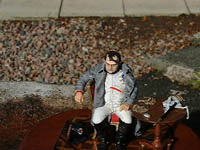 Opening the box I was immediately struck by the quality of the casting. The likeness is brilliant; his chair is a work of art on its own. Napoleon is seated across his chair, hat lying on the floor and his sword, epaulettes and snuff box on the table beside him. Even the parquet floor is included as a white metal casting, which rewards careful painting. All 30 parts are beautifully cast in white metal and only the faintest of moulding lines need be removed prior to undercoating and painting. Opening the box I was immediately struck by the quality of the casting. The likeness is brilliant; his chair is a work of art on its own. Napoleon is seated across his chair, hat lying on the floor and his sword, epaulettes and snuff box on the table beside him. Even the parquet floor is included as a white metal casting, which rewards careful painting. All 30 parts are beautifully cast in white metal and only the faintest of moulding lines need be removed prior to undercoating and painting.
Assembly of the model is straightforward enough except for a couple of points. Do not fix the left arm until the tunic below is painted or you won't be able to get at it. Secondly, (and here I have to thank the reviewer in the article I read) - the fit of the right arm is very good unpainted, once painted it is extremely tight and as it incorporates a slot to accommodate the chair back, I found it better to leave it off until Napoleon is seated as recommended by the reviewer. I used a very small amount of filler to close the gap between arm and chair back, but this was probably needed because I didn't achieve exactly the right fit - I don't know. Otherwise, as I said construction is straightforward. Get me my brushes 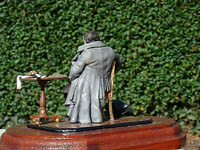 I have recently been converted to Vallejo acrylics, having thought at one time I would never take to them, I am now enjoying them so much I have about 50 tubes of oil paint drying out! I have recently been converted to Vallejo acrylics, having thought at one time I would never take to them, I am now enjoying them so much I have about 50 tubes of oil paint drying out! This figure was a bit of a transition piece - some parts I was afraid to try acrylics on (face and overcoat coat), others I chanced using acrylics on! The face was painted in my usual oil mix of Gold Ochre, Titanium White and Burnt Sienna. The shading used a little more Burnt Umber than I normally would in an attempt to make him look worn out. A little W&N Flesh tint was also added to the checks. The overcoat was painted in various combinations of Lamp Black and Titanium White and then blended to achieve the desired effect of light and shade. The rest of the figure was painted in acrylics. The white part of his tunic and waistcoat were painted in white, shaded with the addition of a little Pale Blue. The breeches were painted White but shaded by adding a little Buff,with an attempt to distinguish between different types of cloth etc. The red sash and cuffs were painted Vermillion and the collar and visible portion of the tunic were painted Dark Blue. The chair cushion and back was painted Carmine Red and the frame with a bright gold printers ink The table was painted Mahogany and streaked with Burnt Umber and Orange Brown whilst still wet to represent the grain. The sword belt was painted White and shaded by adding a little Pale Green. The snuff box was painted in white pearlescent paint to represent Mother of Pearl (the real snuff box, which is in the French Army Museum is mahogany but I felt it would be "invisible" on a mahogany table and so used a little artistic licence). The epaulettes were painted in gold printers ink and liberally shaded with Burnt Umber. Napoleon's famous bicorne lies on the floor and Is detailed inside and out so that the painter can have a go at painting the silk lining - I did mine a bright green to contrast with the other colours on the model. 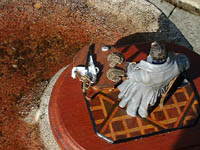 The floor is a real gem, I painted the geometric patterns using Yellow Ochre, Black Orange Brown and Mahogany and then gave it a couple of washes with Vallejo Wood Grain to age it.. If you feel I may have glossed over the painting a bit, well I have, if you are spending nearly £50 on a figure I assume you know how to paint it. The floor is a real gem, I painted the geometric patterns using Yellow Ochre, Black Orange Brown and Mahogany and then gave it a couple of washes with Vallejo Wood Grain to age it.. If you feel I may have glossed over the painting a bit, well I have, if you are spending nearly £50 on a figure I assume you know how to paint it.
Conclusion Napoleon now proudly sits atop my desk and continues to give me pleasure. Several friends have commented favourably on the model which is more to Andrea's credit than mine, but it is a lovely piece. I thoroughly enjoyed making and painting the kit and would wholeheartedly recommend it to anyone. The only pitfall could come if insufficient care is taken fitting the right arm, otherwise if you are only ever going to make one model of Napoleon make it this one! Recommended. This kit is available direct from Andrea via their website www.andrea-miniatures.com or many stockists through out the world, mine came from Historex Agents in the UK. | 








|
